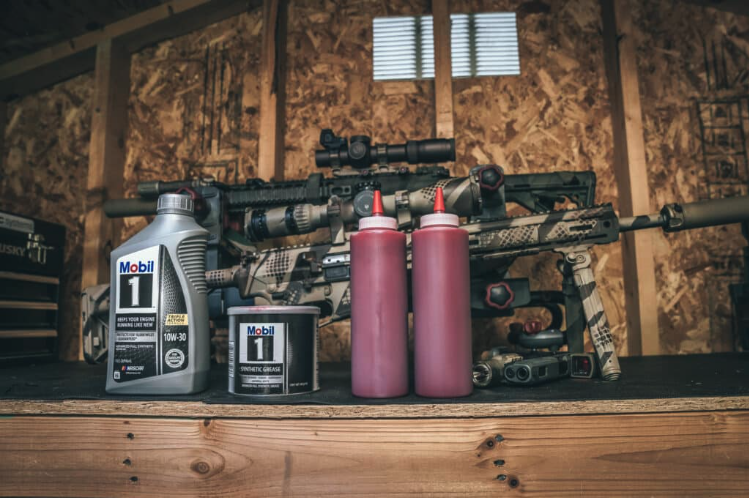
*Originally published on the RE Factor Tactical blog
Before diving into how to make gun oil lubricant or why it may benefit you, let’s get one thing straight.
Everyone has a preference for firearms, holsters, optics, and even gun lubricants or greases.
If you’re happy with what you’re currently using, then, by all means, keep doing what you’re doing.
In the decade I’ve spent shooting and cleaning firearms, I’ve owned dozens of gun oils and greases. Some performed better than others, and when visiting a local shop where I’ve had many of my firearms worked on, I stumbled across a homemade gun oil that the gunsmith and USPSA shooter had been using.

He was gracious enough to share the simple ingredients with me, and since it has performed exceptionally well and has saved me money in the long run, I wanted to share it with you as well.
Since discovering this homemade lubricant, I’ve been using it exclusively on my Glock, AR15, and AR10. I’ve found it to be just as, if not more effective, than other lubricants I’ve used in the past.
To name a few, I’ve used CLP, Breakthrough Clean’s oil/grease, Weapon Shield, Lucas Gun Oil, and M-PRO gun oil.
I typically shoot anywhere from 100-300 rounds per range session with my AR15, around 100-200 rounds with my AR10, and 200-300 rounds of 9mm with my Glock. Both of my ARs run suppressed, which leads to the lubricants I’ve used in the past burning off significantly faster than unsuppressed rifles.
With pistols, I rarely see any lubricant dissipate quickly, but it’s nice to see a healthy presence of lubricant when cleaning after a range session. With suppressed rifles, it’s an entirely different story. It wasn’t uncommon for me to bring lubricant to the range for extended rifle shooting and add more lubricant after a few hundred rounds to ensure I had no issues.
Most of these lubricants dissipated almost completely in a short 150-250 round range session with a suppressor. What I’ve found with this new homemade gun oil lubricant is that it tends to stay on my Bolt Carrier Group for much longer than some of the other products I’ve used. The performance of this lubricant has been exceptional in my experience and is also cost-effective.
Homemade Gun Oil Lubricant
The grease and the oil will cost you between $20-40, depending on where you shop. In comparison, that may seem like a lot to spend on gun lubricant, but buying these two items one time has left me with enough to last year’s.

The photos show how much lubricant was yielded from buying one quart of oil and a one-pound can of synthetic grease. Considering how much some of the lubricants designed for firearms can cost, I think the extra effort to make my own justifies the cost.
So, what are the disadvantages of using this homemade lubricant? There are two that stand out the most.
The first is that this is a lubricant; while it may have properties that say it prevents rust and corrosion, lubricants specifically made for firearms will do a better job of preventing these. Because I live in dry Colorado, they’re rarely a concern.
The second is that the oil and grease have chemicals that can be harmful if ingested. If you prefer lubricants that don’t have some of these chemicals, then Breakthrough Clean is an excellent alternative. Beyond these two points, I haven’t perceived any disadvantages to using this homemade lubricant.
How To Make Gun Oil Lubricant
To get started, you’ll need two ingredients that you can find in numerous auto parts stores and likely Walmart or other similar chains.
You’ll need Mobil 1 Synthetic Grease, Mobil 1 10W-30 synthetic motor oil, and a container to mix the two.

I would also recommend picking up some kind of separate containers or dispensers to store and use the lubricant, but you can also keep it stored in the main container you use to mix both ingredients.
I picked up containers that resemble condiment dispensers that you see in restaurants, but it’s a matter of personal preference.
To make the lubricant, I recommend a 3-part oil to a 1-part mixture of grease. Essentially, you want to mix the two parts to achieve the consistency or viscosity of honey.

From there, it’s simply a matter of putting the lubricant into the containers of your choice and applying it to your firearms in the same fashion you would other lubricants.
Stay tuned to The Gear Bunker and be a part of this all veteran-owned website. And be sure to subscribe to our Facebook, Instagram, and YouTube channels. Sign up to be notified on YouTube ensuring you’ll know immediately when new content is uploaded.
Check out our new Affiliate Partner Page.
Visit our Amazon Storefront for more related items.


Leave a Reply